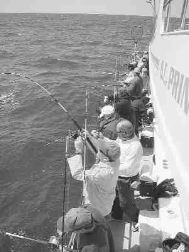
Every species of local sportfish may, at one
time or another, be found in, above, or around offshore reefs.
Local headboats offer seasonal day trips to these artificial
structures.
|
If I had my way, the only bills in this world would be the ones
on the front of hats, ducks and offshore gamefish. But like everyone
else I have my share of "paper" bills to pay, so a couple times a
month I sit down with a checkbook and calculator and do my best to
maintain my credit rating.
Most people will probably agree that writing checks for
utilities, insurance premiums, or tax payments is never fun, it just
seems like money going out the window with nothing tangible to show
for it. But there are a few (very few) bills that I really don't
mind seeing in my mailbox, because the return on investment is so
great and so obvious.
One such bill was delivered just the other day and I wasted no
time in turning it around and sending it back with "payment
enclosed." It was time to renew my annual membership in the Ocean
City Reef Foundation and so for a measly $25, I pretty much
guaranteed that this year I would once again enjoy a season of fun
and successful fishing off Ocean City.
For those who are new to these parts, the Ocean City Reef
Foundation was formed a number of years ago by a small group of
fishermen and divers intent on increasing and improving the amount
of artificial fish habitat that lays off Maryland's coast.
Over time they have secured permits to deposit structures in a
number of designated "reef sites." These sites are anywhere from one
to almost 20 miles offshore and are many acres in dimension.
Clean and inert reef material in such diverse forms as pipes,
telephone cable, old ships, concrete rubble, steel railroad parts,
radio towers, army tanks, barges and concrete fish habitat modules
known as "reef balls" have been strategically placed on the bottom
of the reef sites to enhance the aquatic life holding capacity of
the area.
It might seem like a bunch of "junk" to us, but our refuse is an
underwater Hilton complete with waterbeds and in-room food service
to commuting fish just in from a long migration up the Gulf Stream,
tired and sore from dodging sharks, schools of pesky bluefish and
the annoying sea lice that pick at their gills and never stop
asking, "Are we there yet? Are we there yet?"
No sooner does the artificial reef material hit the bottom before
it immediately starts attracting fish species and other critters
seeking shelter. In a few months the structure begins to sprout a
garden of mussels, barnacles, seaweeds and other life forms that
provide a constant food supply for any number of fish that choose to
live among it.
Seabass and tautog are a couple of species that have more or less
become the "poster fish" for mid-Atlantic reef fishing enthusiasts.
But from flounder to marlin, whether they're attracted to the reef
because of the structure itself, or just to be part of the food
chain that surrounds it, darnn-near every species of local sportfish
may, at one time or another, be found in, above, or around offshore
reefs.
As a fisherman, knowing where these reefs are is as important to
me as knowing the locations of the shoals, ridges and drop-offs that
are so evident on local charts. The reefs have become an important
part of our offshore ecosystem and a prominent part of the seafloor
topography. Every structure holds fish of some sort, and whether I'm
trolling for tuna, chumming for sharks, or drifting for whatever,
knowing what reefs are in the area and something about their
composition assists me in planning out a successful fishing strategy
for the day.
Some artificial reefs can be found on local charts, the
coordinates to others are often shared among fishermen. But to get
the complete list of all the reefs built by the OCRF and -- just as
important -- the updates every time new structure is placed
offshore, one needs to cough up the whopping $25 a year membership
fee. The general list is sent out through the mail and the updates
come via both e-mail and newsletters.
Marta Beman is the administrator of the OCRF and can be reached
by calling 410-213-9204 or by e-mail at mailto:ocreef@msn.com The mailing
address is P.O. Box 1072, Ocean City, Md. 21843 and the Web site is
ocreefs.com.
Finally, if you haven't heard by now, Maryland's DNR has
officially settled on a summer flounder management plan for this
year. As long as it's approved by the ASMFC, Maryland anglers in
2003 will be fishing under a 17-inch minimum size limit with no
closed season.
Originally published Friday, February 7, 2003



